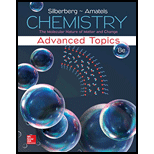
Concept explainers
(a)
Interpretation:
Total number of ions in
Concept introduction:
The molar mass of a substance is defined as the mass of one mole of a chemical entity. It is calculated as the summation of the product of the number of atoms of each element and the
For example, the molar mass of
A mole is a unit of measurement that has the same number of particles as that in
(a)
Answer to Problem 3.17P
Total number of ions in
Explanation of Solution
The formula to calculate the molar mass of
Substitute
The expression to calculate moles of
Substitute
The expression to calculate moles of ions of
Substitute
The expression to calculate number of ions of
Substitute
Total number of ions in
(b)
Interpretation:
Mass (kg) of
Concept introduction:
The molar mass of a substance is defined as the mass of one mole of a chemical entity. It is calculated as the summation of the product of the number of atoms of each element and the atomic mass of the respective element.
For example, the molar mass of
The conversion factor for
(b)
Answer to Problem 3.17P
Massof
Explanation of Solution
The formula to calculate the molar mass of
Substitute
The expression to calculate the mass
Substitute
Mass of
(c)
Interpretation:
Mass (mg) of
Concept introduction:
The molar mass of a substance is defined as the mass of one mole of a chemical entity. It is calculated as the summation of the product of the number of atoms of each element and the atomic mass of the respective element.
For example, the molar mass of
The conversion factor for
(c)
Answer to Problem 3.17P
Mass of
Explanation of Solution
The formula to calculate the molar mass of
Substitute
The expression to calculate moles of
Substitute
The expression to calculate the mass
Substitute
Mass of
Want to see more full solutions like this?
Chapter 3 Solutions
Student Solutions Manual For Silberberg Chemistry: The Molecular Nature Of Matter And Change With Advanced Topics
- Draw the mechanism for the formation of diol by starting with one pen and all in... basic conditions then acidic conditions then draw the mechanism for the formation of a carboxylic acid from your product.arrow_forwardDraw the mechanism for the oxidation of 3-bromo-cyclohexan-1-ol.arrow_forwardConvert the following Fischer projection to Haworth projections. show work and show the arrows please.arrow_forward
- Draw the mechanism for the substitution reaction converting an alcohol into an alkyl halide. If chirality is important to the reaction include it.arrow_forwardWrite, in words three different reactions we can use to make an alcohol.arrow_forwardDraw the reduction mechanism for the reduction of the aldehyde.arrow_forward
 ChemistryChemistryISBN:9781305957404Author:Steven S. Zumdahl, Susan A. Zumdahl, Donald J. DeCostePublisher:Cengage Learning
ChemistryChemistryISBN:9781305957404Author:Steven S. Zumdahl, Susan A. Zumdahl, Donald J. DeCostePublisher:Cengage Learning ChemistryChemistryISBN:9781259911156Author:Raymond Chang Dr., Jason Overby ProfessorPublisher:McGraw-Hill Education
ChemistryChemistryISBN:9781259911156Author:Raymond Chang Dr., Jason Overby ProfessorPublisher:McGraw-Hill Education Principles of Instrumental AnalysisChemistryISBN:9781305577213Author:Douglas A. Skoog, F. James Holler, Stanley R. CrouchPublisher:Cengage Learning
Principles of Instrumental AnalysisChemistryISBN:9781305577213Author:Douglas A. Skoog, F. James Holler, Stanley R. CrouchPublisher:Cengage Learning Organic ChemistryChemistryISBN:9780078021558Author:Janice Gorzynski Smith Dr.Publisher:McGraw-Hill Education
Organic ChemistryChemistryISBN:9780078021558Author:Janice Gorzynski Smith Dr.Publisher:McGraw-Hill Education Chemistry: Principles and ReactionsChemistryISBN:9781305079373Author:William L. Masterton, Cecile N. HurleyPublisher:Cengage Learning
Chemistry: Principles and ReactionsChemistryISBN:9781305079373Author:William L. Masterton, Cecile N. HurleyPublisher:Cengage Learning Elementary Principles of Chemical Processes, Bind...ChemistryISBN:9781118431221Author:Richard M. Felder, Ronald W. Rousseau, Lisa G. BullardPublisher:WILEY
Elementary Principles of Chemical Processes, Bind...ChemistryISBN:9781118431221Author:Richard M. Felder, Ronald W. Rousseau, Lisa G. BullardPublisher:WILEY





